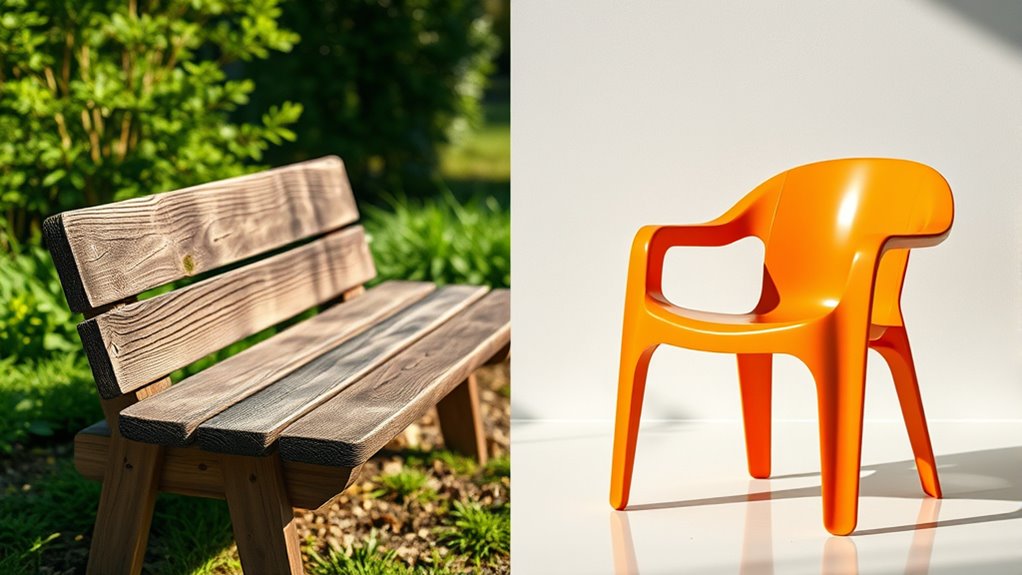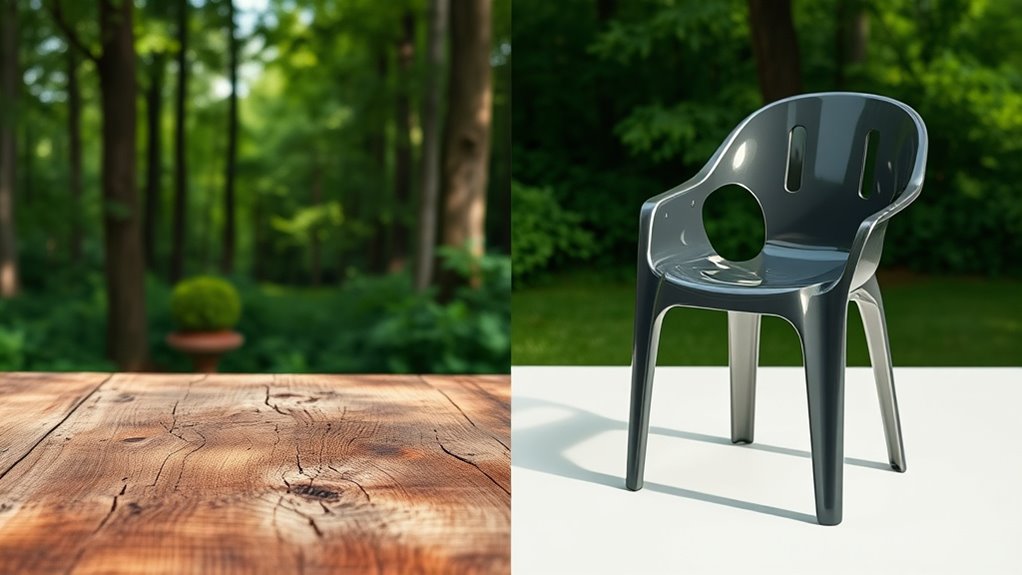When comparing wood and plastic, wood is generally better for the environment because it’s a renewable resource that biodegrades and produces fewer emissions during production. It also has a lower long-term ecological impact since it supports recycling and sustainability when responsibly sourced. Plastic, on the other hand, is derived from finite fossil fuels, pollutes ecosystems, takes centuries to decompose, and causes significant harm to marine life. To understand the detailed differences, keep exploring these factors further.
Key Takeaways
- Wood is a renewable, biodegradable resource with lower lifecycle carbon emissions compared to plastic.
- Plastic production relies on finite fossil fuels, releases toxic substances, and persists in the environment for centuries.
- Wood biodegrades naturally and supports recycling, whereas plastic waste causes long-term pollution and harms marine life.
- Transporting wood consumes more energy due to its weight, but its overall environmental impact remains lower over its lifecycle.
- Sustainable forestry practices ensure a continuous supply of wood, making it a more environmentally responsible choice.
Material Sourcing and Production Impact

When comparing wood and plastic, the environmental impact of sourcing and production is a key factor. Wood is a renewable resource, sourced from sustainably managed forests, which helps reduce its environmental footprint. Its manufacturing impact involves less energy use, mainly for drying lumber, resulting in a lower carbon footprint. In contrast, plastic comes from finite fossil fuels, requiring high energy consumption during extraction and processing. This reliance increases the manufacturing impact and fossil fuel use, releasing harmful substances like furans and dioxins. Using wood byproducts and lower-grade lumber supports sustainable sourcing and minimizes deforestation concerns. Additionally, resource renewability plays a crucial role in assessing their overall environmental impact. Life cycle analysis shows that the production of wood generally generates fewer emissions than plastic, further supporting its eco-friendly profile. Overall, the life cycle of wood typically has a smaller environmental footprint than plastic, making it the more eco-friendly choice when considering sourcing and production impacts.
Transportation and Transportation Energy Use

Transporting wood consumes more energy than moving plastic because its dense cellulose fibers make it heavier and stronger. This increased weight means higher transportation energy use, as more fuel is needed to move wood products. Plastic pallets, being lightweight, reduce fuel consumption and lower emissions during transit, which directly impacts the carbon footprint. The heavier weight of wood complicates transport logistics, requiring more effort and energy, therefore increasing its environmental impact. In contrast, the lightweight nature of plastics simplifies shipping and cuts costs, making transportation more efficient. Overall, the energy required for transporting wood is markedly higher, leading to a larger ecological footprint. This difference in transportation energy use highlights the importance of considering environmental impacts when choosing between wood and plastic for packaging and shipping.
Waste Management, Recycling, and Decomposition

While plastic’s lightweight nature makes it easier to transport, its waste management presents significant challenges. Only about 9% of plastic waste gets recycled globally, leaving the rest to accumulate as environmental pollution, especially in oceans. Plastic can take hundreds to thousands of years to decompose, persisting in landfills and marine ecosystems for centuries. In contrast, wood biodegrades relatively quickly when exposed to environmental elements, breaking down into organic matter that minimizes long-term pollution. Plastic waste often ends up in waterways, harming marine life through ingestion and entanglement. Recycling rates for plastic remain low, complicating waste management efforts. Meanwhile, wood is more widely recycled, reused, or repurposed, supporting a circular economy and reducing environmental impact. Additionally, biodegradable materials are increasingly being developed as sustainable alternatives to traditional plastics to address these environmental concerns. Incorporating environmentally friendly materials into manufacturing processes can further reduce the ecological footprint of consumer products. A life cycle assessment can help consumers and manufacturers understand the full environmental impact of their material choices. Moreover, adopting sustainable design practices can enhance product longevity and minimize waste generation over time.
Environmental Pollution and Ecological Effects

Plastic waste markedly harms the environment and ecosystems through widespread pollution and ecological disruption. Plastic doesn’t biodegrade, so it remains in landfills and waterways for hundreds or thousands of years, contaminating land and marine environments. Nearly 3% of global plastic waste ends up in oceans, causing marine pollution and endangering aquatic life. Marine animals often ingest plastic, leading to death for around 100,000 marine mammals annually. Burning plastic releases toxic gases like furans and dioxins, which pose hazards to wildlife and human health. Unlike wood, which biodegrades naturally and emits controlled CO2 during combustion, plastic’s persistence causes long-term ecological harm. Landfills filled with plastic waste contribute to pollution, disrupting habitats and threatening biodiversity. Recycling efforts are essential to reduce plastic accumulation and mitigate its environmental impact.
Overall Sustainability and Long-Term Benefits

Wood stands out as a more sustainable choice over plastic due to its lower overall carbon footprint and natural biodegradability. Its renewable nature allows it to act as a carbon sink during growth, reducing environmental impact over the long term. Lifecycle assessments show that wood produces fewer greenhouse gases throughout its lifespan compared to plastic. Additionally, wood’s ability to be recycled, reused, or repurposed supports a circular economy, minimizing waste. Unlike plastic, which persists for centuries, wood naturally biodegrades, lessening pollution and ecological harm. Responsible forest management ensures a sustainable supply of wood, making it a better long-term resource. Sustainable forestry practices support a balanced approach to resource use and environmental preservation. Moreover, adopting renewable resource management strategies ensures that forest resources are conserved for future generations. Utilizing eco-friendly materials further enhances the environmental benefits of choosing wood over plastic. Incorporating life cycle assessment data helps highlight the comprehensive environmental advantages of sustainable wood use.
Frequently Asked Questions
Is Wood or Plastic More Environmentally Friendly?
You’re wondering whether wood or plastic is more environmentally friendly. Wood is a better choice because it’s renewable, biodegradable, and has a lower carbon footprint. When you choose wood, you’re supporting sustainable forestry and reducing pollution. Plastic, on the other hand, comes from non-renewable resources, lasts for hundreds of years, and pollutes ecosystems. By opting for wood, you help lessen environmental harm and promote a healthier planet.
Is It Better to Use Wood or Plastic?
When it comes to choosing between wood and plastic, you’re really between a rock and a hard place. You want to make an eco-friendly decision, so think about the bigger picture. Wood is renewable, naturally biodegrades, and actively absorbs carbon, making it a greener choice. Plastic, on the other hand, is derived from fossil fuels, pollutes oceans, and lasts for centuries. So, opting for wood helps you leave a lighter footprint.
Is Using Wood Environmentally Friendly?
Using wood is environmentally friendly because it’s a renewable resource that can be sustainably managed. When you choose wood, you support responsible forestry practices that promote quick biodegradation, reducing long-term pollution. Plus, producing and processing wood uses less energy and emits fewer greenhouse gases than plastics. By opting for wood, you help minimize waste, support eco-friendly practices, and contribute to a healthier planet.
What Material Is More Eco-Friendly Than Plastic?
Imagine choosing a superhero to save the planet—plastic, the villain, lingers forever; wood, the hero, naturally recycles itself. You see, wood is more eco-friendly than plastic because it’s renewable, biodegradable, and has a smaller carbon footprint. When responsibly sourced, it supports sustainable practices and reduces pollution. So, if you’re looking to help Mother Earth, go for wood—nature’s own green champion—rather than plastic’s villainous, long-lasting waste.
Conclusion
So, as you weigh the environmental pros and cons of wood versus plastic, remember that each choice carries hidden impacts. Will one clearly emerge as the greener option, or is the truth more complicated than it seems? Your decision could tip the balance toward sustainability or deepen ecological challenges. The real question is: which material aligns best with your values—and what surprises might you uncover along the way? The answer awaits, just beyond the surface.









